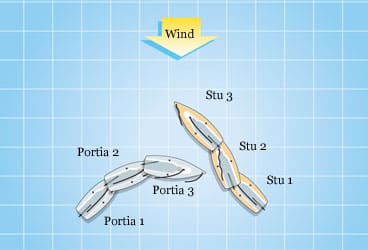
Rule
One of the primary purposes of the racing rules is to reduce the risk of damage and injury while we race our boats in close proximity to other boats, to marks, and to obstructions. So it should be no surprise that quite a few rules are devoted to keeping boats away from potential dangers. It is, however, surprising that those very rules use a remarkably large number of different words and phrases to describe the required separation between boats and between boats and objects. This is the first of a two-part series designed to help you answer the question, “How close is too close?”
I’ve identified the words and phrases you need to understand in order to be able to answer the question in all of the many different situations in which it could arise. They are: “keep clear” (in italics), “give room,” “avoid,” “not interfere,” “keep clear” (without italics), “get clear,” “get well clear,” and “clear” used as a verb, in “clear the finishing line” and “clear a finishing mark.” The most frequently used of all these is “keep clear” in italics, which is used in nine different places in the Part 2 rules, and “give room,” which is also used in nine different places in Part 2. “Keep clear” is in Rules 10, 11, 12, 13 (in both the first and third sentence), 19.2(c), 22.1, 22.2 and 22.3, while “give room” is in Rules 15, 16.1, 18.2(a), 18.2(b) (in both the first and second sentence), 18.2(c), 18.3(b), 19.2(b) and 20.1. Let’s first explore how we answer the question, “How close is too close?” in rules that contain a requirement for a boat to keep clear.
The definition Keep Clear includes two criteria for the distance that boats must maintain from one another. The first applies at all times and the second is an additional criterion that applies only when the boats involved are overlapped and on the same tack.
We use the first criterion many times in a typical buoy race. ISAF Case 88, which I consider the most helpful of all the cases in the ISAF Case Book, covers the port-starboard incident shown in the diagram. Whether or not Rule 10 is broken in this situation depends solely on whether Portia, on port-tack, comes so close to Stu, on starboard, that Stu must take avoiding action.
Here are the facts: Stu hailed “Starboard” twice—when Portia was about three lengths away and again when she was about two lengths away. With no response from her, and fearing a serious collision, Stu began to luff as shown in the diagram. Just after Stu began to luff, Portia put her tiller hard over to port and began to bear off. When Stu realized that Portia was bearing off, he reversed his helm in an effort to swing his stern away from Portia’s bow and to avoid tacking right in front of her. A collision was narrowly avoided, but the separation between the boats was only about two feet when Portia’s bow flashed past Stu’s stern. Stu protested Portia for breaking Rule 10. The protest committee found the neither boat broke a rule and dismissed his protest. Stu then appealed to US Sailing and that appeal is now ISAF Case 88.
The appeals committee’s decision is so clear and helpful that it is worth quoting substantial parts of it (italics and skippers’ names have been added): “Rule 10 required Portia to keep clear of Stu. ‘Keep clear‘ means something more than ‘avoid contact’; otherwise the rule would contain those or similar words. Therefore, the fact that the boats did not collide does not necessarily establish that Portia kept clear. The definition Keep Clear in combination with the facts determines whether or not Portia complied with the rule. In this case, the key question raised by the definition is whether Stu was able to sail his course ‘with no need to take avoiding action’.”
The committee provides a useful list of the factors that affected their answer to that question. The list includes: the courses and relative positions of the boats, the distance between the boats when they changed course, the estimated time before contact, the extent of the course change needed by each boat to avoid a collision, and the time required by the each boat to make the necessary course changes. The latter is significantly affected by the boat’s weight, hull shape, rudder size, and the sail handling required, as well as her speed, the wind strength and the sea conditions.
Here is the reasoning that led the committee to its decision: At Position 1 “a collision was imminent, and almost unavoidable, as shown by the fact that with helm hard over Portia passed less than two feet from Stu’s stern. At [Position 1], Stu had no assurance that Portia had heard his hails, or was preparing to change course, or even that Portia was aware of his presence. Also, Portia had sailed beyond the point at which she should have borne off, either to minimize the time and distance to reach the windward mark or to sail a course chosen for tactical reasons. Stu was fully justified in expecting a collision and in concluding that only his action would prevent it.” The committee concluded that, at Position 1, Stu needed to take avoiding action and, therefore, it disqualified Portia under Rule 10 for not keeping clear.
The second criterion in the definition Keep Clear applies far less frequently than the first. It only crops up when two boats overlapped on the same tack are sailing with very little lateral distance between them. In my experience, almost all incidents of this sort occur shortly before or at the start while boats are jockeying for position on starboard tack and the windward boat becomes very close to the leeward boat. The windward boat breaks Rule 11 by failing to keep clear of the leeward boat if the distance between the boats becomes so small that if the leeward boat were to change course, either by luffing or by bearing away, she would immediately make contact with the windward boat.
The meanings of “immediately” are “without delay, at once, instantly.” This implies that windward and leeward must be very nearly touching in order for the windward boat to be failing to keep clear. Of course, the distance will be influenced by the speed of the boats and the sea conditions. If the boats are moving fast or if the seas are choppy, the windward boat will fail to keep clear when the boats are farther apart than they would need to be if the boats were moving slowly and the seas were negligible. In a soon-to-be-published US Sailing appeal, two 44-foot keelboats were approaching the starting line overlapped on starboard tack sailing slowly in very light wind and smooth water. At the point in the incident when the lateral separation between the boats was the smallest, the bow of the leeward boat was about 10 feet forward of the stern of the windward boat, and the lateral distance between the boats was only 3 feet. Even though that lateral distance was quite small, the appeals committee decided that windward was keeping clear of leeward at that point because the boats were not so close that contact would have been made at once or instantly had leeward begun to luff.
Have a question for our resident rules expert? E-mail rules@sailingworld.com.









